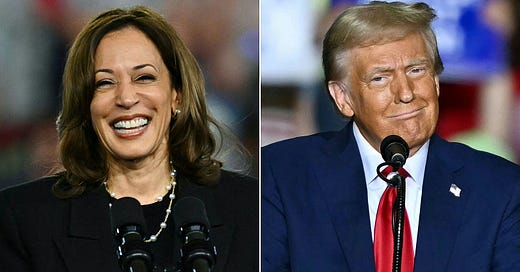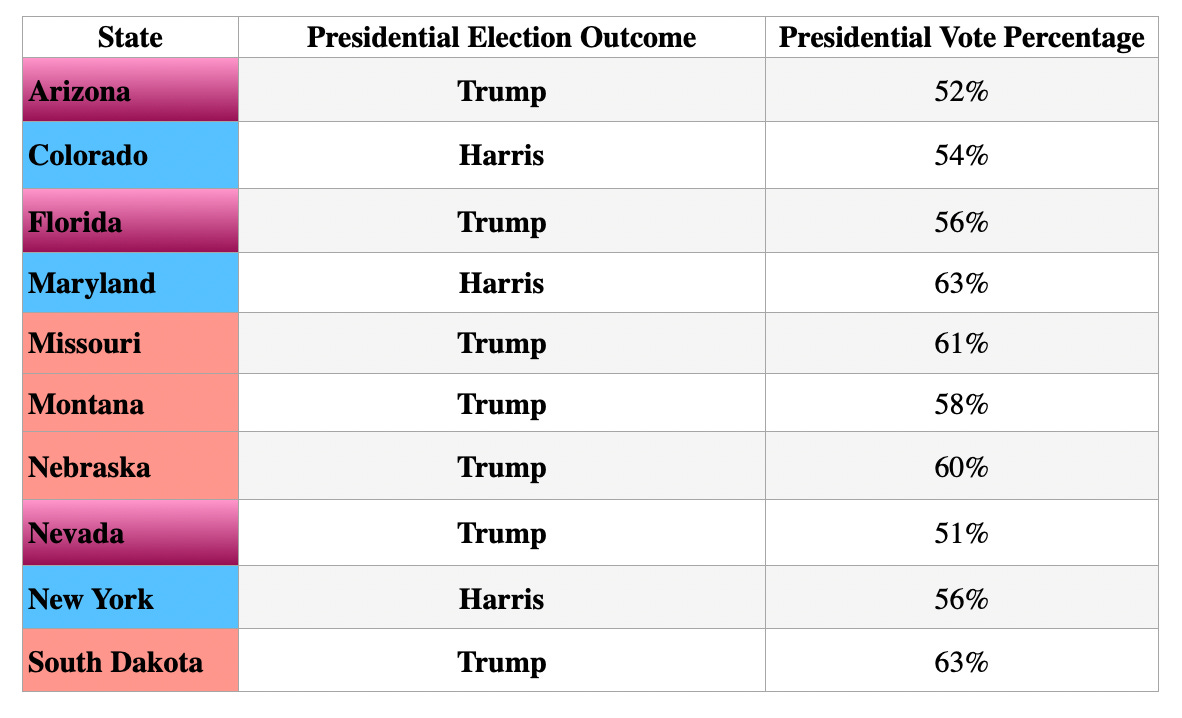Did Trump win the election because abortion was on the ballot?
Exploring an idea, hoping for a conversation.
I have been thinking whether it is worth writing about this. Many more qualified than I have written about Trump’s election.
I want to address a particular issue I have not seen discussed much after the election. An article on ABC did something similar — totally independently. So did the NYT, but neither raises the same issue I discuss.
When I saw that abortion was on the ballot in many states, I thought that this would drive pro-choice voters to the polls and that these voters would also support Kamala Harris, the presidential candidate who would be more likely to support abortion rights (Silly me). Thus, I expected that if abortion won, so would Kamala Harris, with a similar number of votes. If anything, I expected her to outperform pro-choice initiatives because some democratic voters may be pro-life.
I have not been writing as much as I would like to. For today’s post, I want to propose an argument I am playing with. I am not making any strong claims, only pointing out that this could be part of the conversation. I am hoping to make this into a conversation.
Further, the data for this post was recapitulated by our dearest, CHATGTP. It did horribly, so I reworked the numbers using Ballotpedia and the NY Times (trying to save time ended up costing me time).
I want to explore whether this was the case or not. Did these ballot initiatives essentially untangle the issue of women’s right to choose an abortion? The day after the election, I had a conversation with a collaborator, and the idea came to me that this would be worth looking into.
I think by offering abortion as a ballot initiative, these issues were untangled. It could be valuable to investigate who proposed these initiatives and whether they did so with the intent to impact the election outcome.
There were ten states and eleven initiatives/questions related to expanding, enshrining, or restricting a woman’s right to choose to terminate a pregnancy. In the following tables, I have colored-coded states as a battleground (purple), democratic (blue), and republican (red).
The summary of each measure was provided by our friend, ChatGTP.
We see that in most cases, the public supported measures that enshrined or increased abortion rights. Only in Nebraska were rights restricted, but only after the first trimester, and in Florida, a constitutional right was not approved despite more than half of the voters supporting it. (Why do some states require different percentages is beyond me).
For perceptive readers, you may already have realized that my assumption about voting patterns was mistaken. But before we get there, let us examine how people in these states voted in the general election.
Finally, I want to compare voters who supported pro-choice initiatives with Harris’ support. For simplicity I am looking at rounded percentages. Thus, the final column will be %voters who voted for prochoice minus %voters who voted for Harris.
For example, in Arizona Harris got 48% of the vote, and 62% of people vote in favor of a proposition establishing the right to aborition. The calculation for the final column would be 48 - 62 =-14. (I know you are all here for simple math examples). Thus, Harris got 14% less votes than I would have expected given my MISTAKEN assumption about voting patterns.
In this column, a positive result means more people voted for Harris than for pro-choice, a negative result shows that more people voted for prochoice than for Harris, and a result of zero that more or less the same amount of people voted for each.
So if all these prochoice voters would have voted for Harris, she would have won all these states except South Dakota, and Nebraska. She would be president.
I am not claiming, all those voters would have supported Harris had abortion not been untangled from the choice for president. Yet, I am tempted to think that in cases were the election was close such as Arizona and Nevada, having the question of abortion entangled could have shifted some people’s presidential vote because some people tend to vote based on single issues. In these two cases 4-5% of those that supported choice would have to have voted for Harris instead of Trump. These two states flipping would have been insufficient to change the outcome of the general election.
The next closest state in the list is Florida, where its hard to think that enough prochoice voters would have supported Harris over Trump had the issue not been untangled. Trump got 58% of the vote, and almost all the voters who voted for abortion and for Trump would have had to change their choice for president.
I do think that untangling these issues allowed voters to think about who they supported for president while sidestepping the candidate’s thoughts on whether women should have a right to chose to terminate a pregnancy. This separation is even revelant for single issue voters or ones that consider the issue to be the most important. These voters could, essentially, ignore the presidential candidate’s views on the question of abortion because the question of abortion was left to be determiend by referendum.
I wonder how these questions, initiatives made it to each of these ballots. Who proposed them? Did they consider how these ballots may impact the outcome of the presidential election? Are these effects ever considered? How would we measure them?
Did pro-choice supporters envisioned such initiatives increasing turnout and assumed these voters would vote for choice and for Democrats? Was the DNC involved in supporting such initiatives? Did GOP partisan encouraged these questions being decided by vote in an effort to untangle the issue of abortion from that of the choice for president? Did any of the two parties try to game the election through issue unentanglement?
Prochoice initiatives in the ballot outperformed Harris by an average of 11%. I have not seen much discussion of this difference nor efforts to consider the ways in which untangling issues impacts elections. Maybe I have not been looking thoroughly (after writing this I found an article on ANC and one in the NYT linked above). Neither of these offers the same perspective though both mention a disparity between pro-abortion votes and Harris’s performance.
Maybe this post is a waste. I am not even sure what I am arguing or if there are any lessons to be drawn. Maybe all I wanted was to play with an idea. And I am certainly too lazy to chase the history behind each of these proposals. Maybe we should be more daring, and share work-in-progress.
Perhaps, the value of Substack, is that we can all play in the sand, building castles and sometimes leaving them half finished. I wonder what ….








While certainly on the cards, I suspect that abortion is one of the many in a bag of factors that propelled Trump and the GoP to victory. Nevertheless, interesting exercise in a world captivated by what's going on across the Atlantic.
My suspicion is that people would mostly still have voted the way they did, if abortion had not been on the ballot, because they would have prioritized economic concerns over abortion freedom concerns. This is a guess based on hearing many trusted pundits talking about polls, trends, etc.